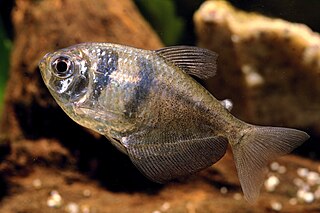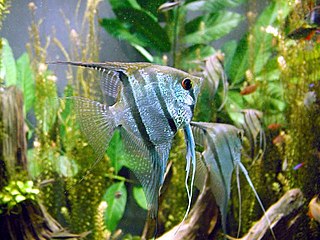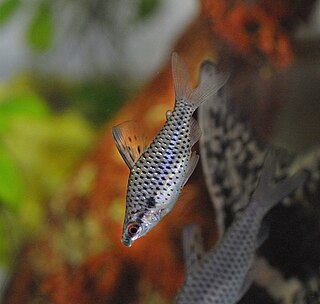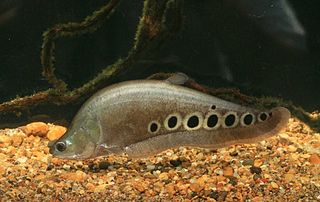
The striped bass, also called the Atlantic striped bass, striper, linesider, rock, or rockfish, is an anadromous perciform fish of the family Moronidae found primarily along the Atlantic coast of North America. It has also been widely introduced into inland recreational fisheries across the United States. Striped bass found in the Gulf of Mexico are a separate strain referred to as Gulf Coast striped bass.

The black tetra, also known as the black skirt tetra, petticoat tetra, high-fin black skirt tetra, black widow tetra and blackamoor, is a freshwater fish of the characin family (Characidae). It is native to the Paraguay River basin of south-central Brazil, Paraguay and northeast Argentina, but there are also populations in the upper Paraná and Paraíba do Sul Rivers that likely were introduced. It was formerly reported from the Guapore River, but this population is part of G. flaviolimai, which is found throughout the Madeira River basin and was described in 2015. The black tetra is often kept in aquariums.

Tanichthys micagemmae is a species of freshwater ray-finned fish. It is a member of the carp family of order Cypriniformes. It was only discovered in 2001, in a tributary of the Bến Hải River in Quảng Bình Province, Vietnam. Its range includes what was the demilitarized zone between North and South Vietnam and was subject to intense bombing during the Vietnam War.
Anostomus is a small genus of fish in the family Anostomidae found in South America. They are found in the Orinoco and Amazon Basin, as well as various rivers in the Guianas. The genus currently contains five described species. Petulanos was until recently included here.

Pterophyllum is a small genus of freshwater fish from the family Cichlidae known to most aquarists as angelfish. All Pterophyllum species originate from the Amazon Basin, Orinoco Basin and various rivers in the Guiana Shield in tropical South America. The three species of Pterophyllum are unusually shaped for cichlids being greatly laterally compressed, with round bodies and elongated triangular dorsal and anal fins. This body shape allows them to hide among roots and plants, often on a vertical surface. Naturally occurring angelfish are frequently striped transversely, colouration which provides additional camouflage. Angelfish are ambush predators and prey on small fish and macroinvertebrates. All Pterophyllum species form monogamous pairs. Eggs are generally laid on a submerged log or a flattened leaf. As is the case for other cichlids, brood care is highly developed.

A headstander is any of several species of South American fish, including Anostomus ternetzi, Anostomus anostomus and members of genus Chilodus from the family Chilodontidae. The name derives from their habit of swimming at a 45° angle, head pointed downwards, as if "standing on their heads".

Synchiropus splendidus, the mandarinfish or mandarin dragonet, is a small, brightly colored member of the dragonet family, which is popular in the saltwater aquarium trade. The mandarinfish is native to the Pacific, ranging approximately from the Ryukyu Islands south to Australia. It can usually be found in some of the warmer waters.

The pyjama shark or striped catshark is a species of catshark, and part of the family Scyliorhinidae, endemic to the coastal waters of South Africa. This abundant, bottom-dwelling species can be found from the intertidal zone to a depth of around 100 m (330 ft), particularly over rocky reefs and kelp beds. With a series of thick, parallel, dark stripes running along its stout body, the pyjama shark has an unmistakable appearance. It is additionally characterized by a short head and snout with a pair of slender barbels that do not reach the mouth, and two dorsal fins that are placed far back on the body. It can grow up to a length of 1.1 m (3.6 ft) long.

Chilodus punctatus, known as the spotted headstander or pearl headstander, is a headstander, a type of fish, in the genus Chilodus. The spotted headstander has a body that extends grayish and green colors over his body and sets off the colors with rows of brown specks.

Taraporewala Aquarium or Taraporevala Aquarium is India's oldest aquarium and one of the city's main attractions. It hosts marine and freshwater fish. The aquarium is located on Marine Drive in Mumbai..

Cleaner fish are fish that show a specialist feeding strategy by providing a service to other species, referred to as clients, by removing dead skin, ectoparasites, and infected tissue from the surface or gill chambers. This example of cleaning symbiosis represents mutualism and cooperation behaviour, an ecological interaction that benefits both parties involved. However, the cleaner fish may consume mucus or tissue, thus creating a form of parasitism called cheating. The client animals are typically fish of a different species, but can also be aquatic reptiles, mammals, or octopuses. A wide variety of fish including wrasse, cichlids, catfish, pipefish, lumpsuckers, and gobies display cleaning behaviors across the globe in fresh, brackish, and marine waters but specifically concentrated in the tropics due to high parasite density. Similar behaviour is found in other groups of animals, such as cleaner shrimps.

Striped Raphael catfish is a catfish of the family Doradidae. It may also be called Southern striped Raphael, talking catfish, chocolate doradid, chocolate catfish or thorny catfish. It is native to the Amazon, Paraguay–Paraná and lower Orinoco basins in South America. This peaceful, nocturnal species is a popular aquarium fish due to its pleasant temperament and curious nature.

The clown featherback, clown knifefish, or spotted knifefish, Chitala ornata, is a nocturnal tropical fish with a long, knife-like body. This knifefish is native to freshwater habitats in Cambodia, Laos, Thailand, and Vietnam, but it has also been introduced to regions outside its native range. It is one of the world's most invasive species.

Schistura mahnerti is a species of tropical freshwater fish of the stone loach family Nemacheilidae. It inhabits fast-flowing streams of Thailand and Myanmar (Burma). S. mahnerti is one of the more recent species to be introduced to the aquarium trade.

Chrysaora colorata (Russell), commonly known as the purple-striped jelly, is a species of jellyfish that exists primarily off the coast of California from Bodega Bay to San Diego. The bell (body) of the jellyfish is up to 70 cm (2.3 ft) in diameter, typically with a radial pattern of stripes. The tentacles vary with the age of the individual, consisting typically of eight marginal long dark arms, and four central frilly oral arms. It is closely studied by scientists due to not much being known about their eating habits.

Dascyllus melanurus, known commonly as the four stripe damselfish, blacktail dascyllus, humbug damselfish, blacktail damselfish, and blacktail humbug, is a species of fish in the family Pomacentridae. It is native to the western Pacific Ocean. It is sometimes kept as an aquarium pet.
Striped headstander may refer to the fish species:
Anostomus ternetzi is a fish in the family Anostomidae.

Doryrhamphus excisus is a species of flagtail pipefish from the genus Doryrhamphus. Its common names include blue-striped pipefish and blue-and-orange cleaner pipefish. The fish is found throughout much of the Indo-Pacific and tropical East Pacific.
Trimma tevegae, commonly known as the bluestripe pygmygoby or blue-striped cave goby among other names, is a species of goby from the western Pacific. They are small fish, averaging at 2 cm (0.79 in), orange-brown with white undersides in life, with characteristic iridescent blue or lavender stripes on the sides and on top of the body. They are usually found in large schools in the sloping or vertical drop-offs at coral reef edges. They are sometimes caught for the aquarium trade, and are also known by hobbyists under the name blue line flagtail goby. The species is named in honor of the schooner Te Vega.

















